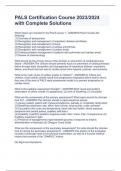PALS Certification Course 2023/2024
with Complete Solutions
Which topics are included in the PALS course ? - ANSWER-PALS includes the
following:
(1) Overview of assessment
(2) Recognition and management of respiratory distress and failure
(3) Recognition and management of shock
(4) Recognition and management of cardiac arrhythmias
(5) Recognition and management of cardiac arrest
(6) Postresuscitation management of patients with pulmonary and cardiac arrest
(7) Review of pharmacology
What should be the primary focus of the clinician on prevention of cardiopulmonary
failure - ANSWER-The clinician should primarily focus on prevention of cardiopulmonary
failure through early recognition and management of respiratory distress, respiratory
failure, and shock that can lead to cardiac arrest from hypoxia, acidosis, and ischemia.
What is the main cause of cardiac arrests in children? - ANSWER-In infants and
children, most cardiac arrests result from progressive respiratory failure and/or shock,
thus one of the aims of PALS rapid assessment model is to prevent progression to
cardiac arrest.
What is the pediatric assessment triangle? - ANSWER-Brief visual and auditory
observation of child's overall (1) appearance, (2) work of breathing, (3) circulation
What are the components of the primary assessment? What signs should the clinician
look for? - ANSWER-The clinician should in rapid sequence assess:
(1) Airway (patent, patent with maneuvers/adjuncts, partially or completely obstructed)
(2) Breathing (respiratory rate, effort, tidal volume, lung sounds, pulse oximetry)
(3) Circulation (skin color and temperature, heart rate and rhythm, blood pressure,
peripheral and central pulses, capillary refill time)
(4) Disability: (a)AVPU pediatric response scale: Alert, Voice, Pain, Unresponsive; (b)
Pupillary response to light
(c) Presence of hypoglycemia (rapid bedside glucose or response to empiric
administration of dextrose) (d) Glasgow Coma Scale
What are the components of the secondary assessment? For what should the clinician
look for during the secondary assessment? - ANSWER-This portion of the evaluation
includes a thorough head to toe physical examination, as well as a focused medical
history that consists of the "SAMPLE" history:
(S) Signs and Symptoms
, (A) Allergies
(M) Medications
(P) Past medical history
(L) Last meal
(E) Events leading to current illness
What are the components of the tertiary assessment? - ANSWER-Injury and infection
are common causes of life-threatening illness in children. Thus, for this stage, ancillary
studies are frequently directed towards identifying the extent of trauma or an infectious
focus.
There are many causes of acute respiratory compromise in children. The clinician
should strive to categorize respiratory distress or failure into one or more of the
following: - ANSWER-(1) Upper airway obstruction (eg, croup, epiglottitis)
(2) Lower airway obstruction (eg, bronchiolitis, status asthmaticus)
(3) Lung tissue (parenchymal) disease (eg, bronchopneumonia)
(4) Disordered control of breathing (eg, seizure, coma, muscle weakness)
What is the focus of initial management - ANSWER-The main focus of initial
management is to support airway, breathing, and circulation
How can the clinician support the airway? - ANSWER-(1) Provide 100 percent inspired
oxygen
(2) Allow child to assume position of comfort or manually open airway
(3) Clear airway (suction)
(4) Insert an airway adjunct if consciousness is impaired (eg, nasopharyngeal airway or,
if gag reflex absent, oropharyngeal airway)
How can the clinician support breathing? - ANSWER-For supporting breathing, the
clinician should:
(1) Assist ventilation manually in patients not responding to basic airway maneuvers or
with inadequate or ineffective respiratory effort
(2) Monitor oxygenation by pulse oximetry
(3) Monitor ventilation by end-tidal carbon dioxide (EtCO2) if available
(4) Administer medications as needed (eg, albuterol, epinephrine)
T of F: in preparation for intubation, the patient should receive 100 percent oxygen? -
ANSWER-True! In preparation for intubation, the patient should receive 100 percent
oxygen via a high-concentration mask, or if indicated, positive pressure ventilation with
a bag-valve-mask to preoxygenate and improve ventilation.
What should be done if the patient cannot maintain their airway, oxygenation, or
ventilatory requirements? - ANSWER-In such cases, the patient should undergo
placement of an artificial airway, usually via endotracheal intubation and less commonly
with a laryngeal mask airway or alternative device.




